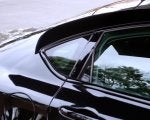I do not recall what path it was that led me, following one page on the Wikipedia to another, to another, and so on, that finally led me to the article on the Opera window, but on finding that article, it struck me right away that my new car had a similar feature. On examining the rearmost side windows on my 2016 Dart, and comparing them to what is shown and described in the article, I have come to the conclusion that these windows do indeed qualify as “opera windows”.
The article describes them as having a history going back at least as far as the 1920s, as having been very common in the 1970s, and having fallen out of use in the 1980s and beyond. Aside from my contribution to the article, adding the 2013-2016 Dart to the list of vehicles known to have had this feature, nothing in the article suggests that any cars were made with it after the 1980s. I wonder what other recent cars, aside from the Dart, there may be with this feature.
![]()
![]()
The article describes them as having a history going back at least as far as the 1920s, as having been very common in the 1970s, and having fallen out of use in the 1980s and beyond. Aside from my contribution to the article, adding the 2013-2016 Dart to the list of vehicles known to have had this feature, nothing in the article suggests that any cars were made with it after the 1980s. I wonder what other recent cars, aside from the Dart, there may be with this feature.






